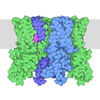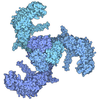[English] 日本語
 Yorodumi
Yorodumi- PDB-9m8s: Cryo-EM structure of the human TRPA1 ion channel in ligand-free state. -
+ Open data
Open data
- Basic information
Basic information
| Entry | Database: PDB / ID: 9m8s | ||||||
|---|---|---|---|---|---|---|---|
| Title | Cryo-EM structure of the human TRPA1 ion channel in ligand-free state. | ||||||
 Components Components | Transient receptor potential cation channel subfamily A member 1 | ||||||
 Keywords Keywords | MEMBRANE PROTEIN / TRANSPORT PROTEIN | ||||||
| Function / homology |  Function and homology information Function and homology informationregulation of blood circulation / positive regulation of monoatomic anion transport / cellular response to food / temperature-gated cation channel activity / regulation of neuronal action potential / cellular response to carbon dioxide / osmolarity-sensing monoatomic cation channel activity / stereocilium bundle / detection of chemical stimulus involved in sensory perception of pain / urinary bladder smooth muscle contraction ...regulation of blood circulation / positive regulation of monoatomic anion transport / cellular response to food / temperature-gated cation channel activity / regulation of neuronal action potential / cellular response to carbon dioxide / osmolarity-sensing monoatomic cation channel activity / stereocilium bundle / detection of chemical stimulus involved in sensory perception of pain / urinary bladder smooth muscle contraction / thermoception / cellular response to toxic substance / cellular response to caffeine / response to pain / TRP channels / calcium ion transmembrane import into cytosol / cellular response to cold / intracellularly gated calcium channel activity / detection of mechanical stimulus involved in sensory perception of pain / positive regulation of insulin secretion involved in cellular response to glucose stimulus / voltage-gated calcium channel activity / monoatomic ion transport / sensory perception of pain / response to cold / calcium ion transmembrane transport / calcium channel activity / cellular response to hydrogen peroxide / intracellular calcium ion homeostasis / cellular response to heat / channel activity / protein homotetramerization / cell surface receptor signaling pathway / apical plasma membrane / response to xenobiotic stimulus / axon / identical protein binding / plasma membrane Similarity search - Function | ||||||
| Biological species |  Homo sapiens (human) Homo sapiens (human) | ||||||
| Method | ELECTRON MICROSCOPY / single particle reconstruction / cryo EM / Resolution: 3.1 Å | ||||||
 Authors Authors | Kang, M.M. / Zhang, Y.M. / Ding, X.F. / Wang, L.J. / Sun, W.Y. / Jiang, H. / Chen, D. / Xu, J.F. / Pang, X.Y. | ||||||
| Funding support | 1items
| ||||||
 Citation Citation |  Journal: Membranes (Basel) / Year: 2025 Journal: Membranes (Basel) / Year: 2025Title: Binding and Activating of Analgesic Crotalphine with Human TRPA1. Authors: Mingmin Kang / Yanming Zhang / Xiufang Ding / Jianfu Xu / Xiaoyun Pang /  Abstract: TRPA1 (Transient Receptor Potential Ankyrin 1), a cation channel predominantly expressed in sensory neurons, plays a critical role in detecting noxious stimuli and mediating pain signal transmission. ...TRPA1 (Transient Receptor Potential Ankyrin 1), a cation channel predominantly expressed in sensory neurons, plays a critical role in detecting noxious stimuli and mediating pain signal transmission. As a key player in nociceptive signaling pathways, TRPA1 has emerged as a promising therapeutic target for the development of novel analgesics. Crotalphine (CRP), a 14-amino acid peptide, has been demonstrated to specifically activate TRPA1 and elicit potent analgesic effects. Previous cryo-EM (cryo-electron microscopy) studies have elucidated the structural mechanisms of TRPA1 activation by small-molecule agonists, such as iodoacetamide (IA), through covalent modification of N-terminal cysteine residues. However, the molecular interactions between TRPA1 and peptide ligands, including crotalphine, remain unclear. Here, we present the cryo-EM structure of ligand-free human TRPA1 consistent with the literature, as well as TRPA1 complexed with crotalphine, with resolutions of 3.1 Å and 3.8 Å, respectively. Through a combination of single-particle cryo-EM studies, patch-clamp electrophysiology, and microscale thermophoresis (MST), we have identified the cysteine residue at position 621 (Cys621) within the TRPA1 ion channel as the primary binding site for crotalphine. Upon binding to the reactive pocket containing C621, crotalphine induces rotational and translational movements of the transmembrane domain. This allosteric modulation coordinately dilates both the upper and lower gates, facilitating ion permeation. | ||||||
| History |
|
- Structure visualization
Structure visualization
| Structure viewer | Molecule:  Molmil Molmil Jmol/JSmol Jmol/JSmol |
|---|
- Downloads & links
Downloads & links
- Download
Download
| PDBx/mmCIF format |  9m8s.cif.gz 9m8s.cif.gz | 485.9 KB | Display |  PDBx/mmCIF format PDBx/mmCIF format |
|---|---|---|---|---|
| PDB format |  pdb9m8s.ent.gz pdb9m8s.ent.gz | 374.7 KB | Display |  PDB format PDB format |
| PDBx/mmJSON format |  9m8s.json.gz 9m8s.json.gz | Tree view |  PDBx/mmJSON format PDBx/mmJSON format | |
| Others |  Other downloads Other downloads |
-Validation report
| Summary document |  9m8s_validation.pdf.gz 9m8s_validation.pdf.gz | 1.3 MB | Display |  wwPDB validaton report wwPDB validaton report |
|---|---|---|---|---|
| Full document |  9m8s_full_validation.pdf.gz 9m8s_full_validation.pdf.gz | 1.3 MB | Display | |
| Data in XML |  9m8s_validation.xml.gz 9m8s_validation.xml.gz | 67 KB | Display | |
| Data in CIF |  9m8s_validation.cif.gz 9m8s_validation.cif.gz | 101 KB | Display | |
| Arichive directory |  https://data.pdbj.org/pub/pdb/validation_reports/m8/9m8s https://data.pdbj.org/pub/pdb/validation_reports/m8/9m8s ftp://data.pdbj.org/pub/pdb/validation_reports/m8/9m8s ftp://data.pdbj.org/pub/pdb/validation_reports/m8/9m8s | HTTPS FTP |
-Related structure data
| Related structure data |  63720MC  9m8nC M: map data used to model this data C: citing same article ( |
|---|---|
| Similar structure data | Similarity search - Function & homology  F&H Search F&H Search |
- Links
Links
- Assembly
Assembly
| Deposited unit | 
|
|---|---|
| 1 |
|
- Components
Components
| #1: Protein | Mass: 127660.570 Da / Num. of mol.: 4 Source method: isolated from a genetically manipulated source Source: (gene. exp.)  Homo sapiens (human) / Gene: TRPA1, ANKTM1 / Cell line (production host): HEK293F / Production host: Homo sapiens (human) / Gene: TRPA1, ANKTM1 / Cell line (production host): HEK293F / Production host:  Homo sapiens (human) / References: UniProt: O75762 Homo sapiens (human) / References: UniProt: O75762Has protein modification | N | |
|---|
-Experimental details
-Experiment
| Experiment | Method: ELECTRON MICROSCOPY |
|---|---|
| EM experiment | Aggregation state: PARTICLE / 3D reconstruction method: single particle reconstruction |
- Sample preparation
Sample preparation
| Component | Name: transient receptor potential cation channel subfamily A member 1 Type: COMPLEX / Entity ID: all / Source: RECOMBINANT |
|---|---|
| Source (natural) | Organism:  Homo sapiens (human) Homo sapiens (human) |
| Source (recombinant) | Organism:  Homo sapiens (human) / Cell: HEK293F Homo sapiens (human) / Cell: HEK293F |
| Buffer solution | pH: 8 |
| Specimen | Embedding applied: NO / Shadowing applied: NO / Staining applied: NO / Vitrification applied: YES |
| Vitrification | Cryogen name: ETHANE |
- Electron microscopy imaging
Electron microscopy imaging
| Experimental equipment |  Model: Titan Krios / Image courtesy: FEI Company |
|---|---|
| Microscopy | Model: TFS KRIOS |
| Electron gun | Electron source:  FIELD EMISSION GUN / Accelerating voltage: 300 kV / Illumination mode: FLOOD BEAM FIELD EMISSION GUN / Accelerating voltage: 300 kV / Illumination mode: FLOOD BEAM |
| Electron lens | Mode: OTHER / Nominal defocus max: 2000 nm / Nominal defocus min: 1000 nm |
| Image recording | Electron dose: 60 e/Å2 / Film or detector model: GATAN K2 SUMMIT (4k x 4k) |
- Processing
Processing
| EM software | Name: PHENIX / Version: 1.21.1_5286 / Category: model refinement |
|---|---|
| CTF correction | Type: PHASE FLIPPING AND AMPLITUDE CORRECTION |
| 3D reconstruction | Resolution: 3.1 Å / Resolution method: FSC 0.143 CUT-OFF / Num. of particles: 148984 / Symmetry type: POINT |
 Movie
Movie Controller
Controller



 PDBj
PDBj

